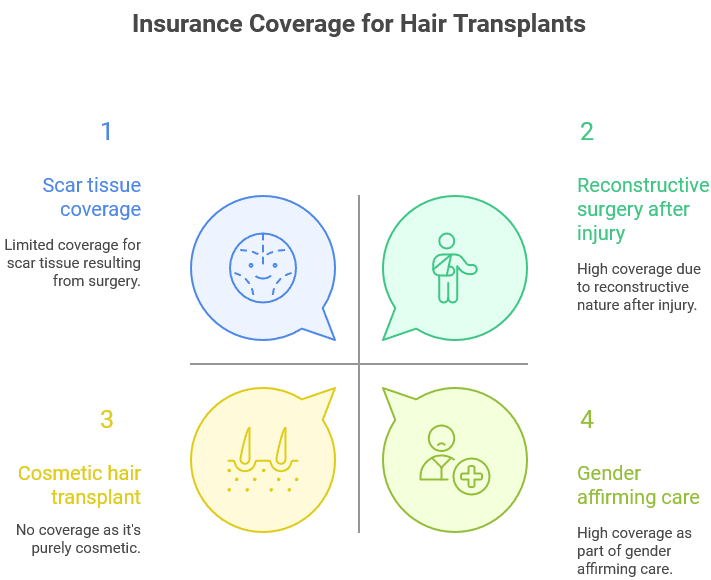While there are hundreds of thousands of patients undergoing hair transplant surgery each year, it is rarely covered by insurance. People are usually expected to pay for these out of their own pocket, as they are not considered to be essential but rather cosmetic procedures, which most insurance plans simply do not include.
Are there cases in which these operations might be covered, and what can you do? Let’s find out.
When Insurance Might Cover a Hair Transplant
In general, any procedure that is part of a reconstructive process after an accident leading to physical damage that leaves a scar or burns will be covered, including plastic and hair restoration surgery.
You may also be able to get coverage if it’s done to cover up scar tissue on the scalp that is the result of brain surgery. However, cancer patients undergoing chemotherapy are not suitable candidates as their hair can grow back on its own after the treatment.
Types of Insurance That Could Help
While the above guidelines apply to a broad range of cases, there are still some options that can prove useful. Here are a few cases where you may actually be covered for hair transplant procedures.
Private Health Insurance Plans
If a transplant is part of a pre approved medical procedure like reconstructive surgery after an injury or illness that leaves your scalp scarred or results in bald patches, then a private plan could prove useful.
Employer-Provided Health Insurance with Enhanced Coverage
These are usually similar to the previous type, although they can cover a wider range of potential scenarios and supported conditions, including workplace accidents, or if the transplanted hair is a part of gender affirming care.
Premium and Specialized Policies
A favorite among celebrities, such policies can include purely cosmetic operations, as part of insuring a recognizable part of one’s brand image, e.g., a specific hairstyle. Some premium options may simply have a looser definition of what is considered “reconstructive surgery” and may include hair transplants.
Health Savings and Flexible Spending Accounts
These options can provide a tax-free way to pay for the surgery and any additional prescribed medication, but only if a physician confirms that it is a medical necessity. They can often help with procedures not covered by standard policies, but that fit the IRS definition of “deductible medical expenses”.

Steps to Check if Your Insurance Covers a Hair Transplant
Here is what you’ll need to do to determine the extent of your coverage:
- Go over the specific definitions: what is considered “cosmetic” and “reconstructive”, and what types of procedures are included will vary, so be sure to read the fine print.
- Have a conversation with your provider: If you’re not 100% sure, you can always contact customer support and ask about hair surgery.
- Ask your doctor for a letter of medical necessity: This official document can take your case from the purely aesthetic and place it firmly into the reconstructive category.
- Prepare your pre-authorisation documents: If this is required, you should provide all your medical records related to the previous injury and the doctor’s letter, along with pictures, and anything else that is needed.
Go over all these steps carefully, and don’t be afraid to ask directly about your options.
Why Insurance Often Doesn’t Cover Hair Transplants
The main reason most plans rarely cover it is that it’s typically a purely aesthetic procedure that doesn’t address any underlying health risks or help the person live their day-to-day life with more ease.
Getting a Hair Transplant Abroad
There are many options available, but is it a good idea to get the surgery in another country? Well, a lot of places now offer the most cutting-edge methods, and you don’t have to worry about scarring or a patchy look like with the old Follicular Unit Transplant (FUT) technique. Apart from that, the hair transplant cost is also much lower.
Why Turkey is a Popular Choice
First of all, you can expect the highest quality service and experienced doctors, often with 10,000+ operations under their belt. The top clinics use the latest hair restoration procedures like Follicular Unit Extraction (FUE), often with sapphire-tipped blades, and preserve hair grafts in special solutions to ensure high survival rates, and give you a denser look while minimizing side effects. It’s currently the best option at an affordable price.
Cost Comparisons: U.S. vs. Turkey
Speaking of prices, here is a quick look at how Turkish clinics compare to those in the West:
Grafts | Method | Turkey (USD) | U.S. (USD) |
2500–3000 | FUE | 2,500–4,000 | 7,500–30,000 |
DHI | 2,500–5,500 | 8,625–34,500 | |
3500–4500 | FUE | 3,500–5,000 | 10,500–45,000 |
DHI | 3,500–6,500 | 12,075–51,750 | |
4500–6000 | FUE | 4,500–6,000 | 13,500–60,000 |
DHI | 4,000–8,000 | 15,525–69,000 |
As you can see, you can get an exceptional hair transplant in Turkey for as much as three times less than in the United States.
FAQs
Does any insurance cover hair transplants?
Yes, certain policies can cover this procedure, especially if it is a part of a broader reconstructive treatment after a physical injury, another surgery, or a burn.
How do I prove my operation is medically necessary?
You will need to talk to your doctor and have them write a letter detailing why this is the case and their personal recommendation. Along with that, you’ll also need to provide medical records and potentially photos of your injuries.
Why is Turkey so popular for hair transplants?
It’s simply one of the best places for a high-quality FUE hair transplant at incredibly competitive prices, and the medical staff has plenty of training and lots of experience.
What’s the cheapest way to pay for the procedure?
Focus on HSA and FSA funds, which can save you up to 35% in taxes if you can prove that it is a necessary operation, and look for all-inclusive packages at Turkish clinics. There are also seasonal promotions that you can take advantage of.

